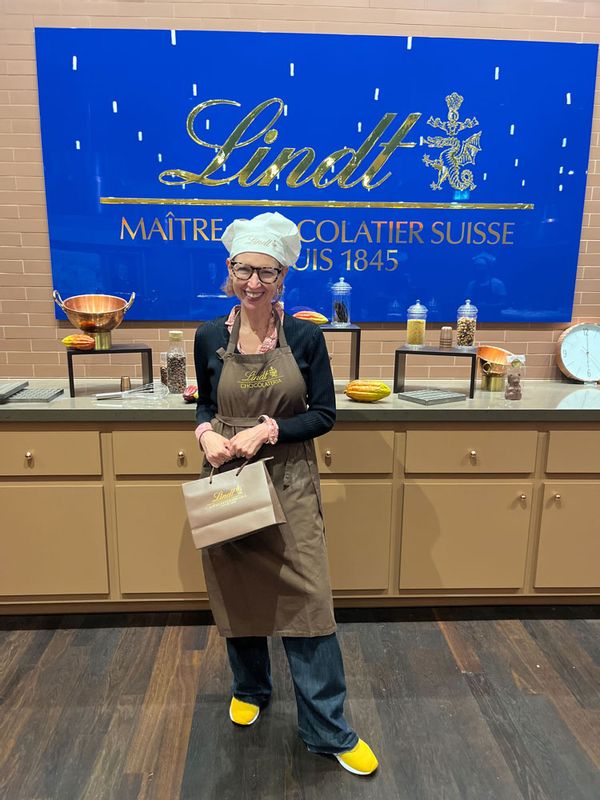The truffle is the size of a golf cart. It sits beneath an enormous, dripping whisk suspended from the ceiling. The chocolate — 370 gallons of it — is real. The Swiss may be known for their neutrality, but at the Lindt Home of Chocolate, the vibe is one of colossal dominance.
“Some people dream of seeing the Eiffel Tower or Big Ben. I wanted to get a selfie under that pterodactyl-sized whisk.”
The supermarket-friendly Swiss chocolatier — which also owns Ghirardelli and Russell Stover and officially operates as Lindt & Sprüngli — has for over 175 years been one of the most familiar and beloved brands in the world. Earlier this year, Tasting Table ranked it at the top of its list of best chocolate, outperforming more expensive and gourmet names like Scharffen Berger and Jacques Genin.
It’s easy to understand why — aside from the variety of flavors and quality of the chocolate itself, Lindt’s real secret weapon is it silkiness. As Tasting Table explains, their chocolate is “high-quality, creamy, and delicious,” with truffles that “are the definition of smooth and offer the perfect amount of chocolate filling in every bite.” And because Lindt chocolate has long been a staple in my own kitchen and, usually, my purse, it was inevitable I’d have to make a pilgrimage while studying in Switzerland for a few weeks. Some people dream of seeing the Eiffel Tower or Big Ben. I wanted to get a selfie under that pterodactyl-sized whisk.
Swiss chocolate isn’t limited to Lindt, of course. There’s the duty-free shop classic, Toblerone, one the first milk chocolate brands in the world and in my opinion the greatest. There’s Teuscher, which makes some of the most elegant and beautifully packaged truffles on earth. There’s Ragusa, the choice of hazelnut obsessives. There’s Callier, a bar that can inspire Proustian reveries across generations of Eurail clutching backpackers. (If you never ate a Callier bar for breakfast, did you even a do a semester abroad?) When I go to the supermarket here, the amount of real estate devoted to chocolate in relation to all other foods is roughly in proportion to the dimensions it occupies in my own mind. Here in this famously restrained nation, where I have yet to get a decent pour of wine anywhere, they are downright excessive about their chocolate.
How did chocolate become, as the Lindt Chocolate Competence Foundation describes it, “embedded it into the national identity”? Belgium, the Netherlands and Ecuador are world class about the stuff too, but in terms of per capita consumption (they’re number one), production (200,000 tons a year) and quality (consistently award-winning), Switzerland hits the sweet spot. So if you want to know what makes Swiss chocolate so special, I think it’s practice.
The Swiss weren’t the first Europeans to taste the Mesoamerican delicacy, or the first to sweeten and popularize it back home — that distinction goes to the Spaniards. But what the Swiss did, with a combination of precision and passion, was to innovate its production and techniques.
In the 19th century, the Swiss were enthusiastic about turning chocolate into an industry, launching some of the first chocolate factories in the world. Callier, the oldest still operational chocolate brand in Switzerland, notes that by the time they launched around 1819, the Vevey region was already home to at least seven other chocolate factories. That kind of competition and demand encouraged achievement. Swiss chocolatier Phillip Suchard and his chocolate company pioneered the melanger, a granite grinding machine that turns sugar and cocoa into a smooth paste. His countryman Daniel Peter is credited with inventing milk chocolate, introducing Nestlé ‘s then-new sweetened condensed milk to amp up the sweetness and creaminess of his product. It was Jean Tobler’s eponymous company that had the bright idea of incorporating classic Italian torrone into chocolate, and also became one of the first in the world to package chocolate in portable, breakable, sharable bars.
Then there’s Lindt. Did you ever bite into a piece of chocolate that felt crystalized and gritty? If not for Rodolphe Lindt, it might always be that way.
(Mary Elizabeth Williams)It was Lindt who developed the conche machine, and with it the process of, as the company itself explains, “mixing, stirring and aerating of the heated liquid chocolate to eliminate unwanted acidity and bitterness” while making it smooth and fragrant. When you think of the most buttery, melt in your mouth chocolate you’ve ever had, wherever in the world it’s from, that flavor experience is informed from Swiss technology and expertise.
And Lindt knows this about itself. Its classic ad campaigns tend to feature three recurring images: silky undulating chocolate, an intense chocolatier surveying a gold whisk, and a woman who looks like she’s just opened up her seventh chakra. At the Lindt Home of Chocolate, you will see all of these things.
The Lindt experience is a relatively new attraction in the otherwise cathedral and cobblestone strewn Zurich area. Opened just three years ago, its origins go back a decade, when the Lindt Chocolate Competence Foundation was established to, among other objectives, “safeguard Switzerland’s position as a center of excellence for chocolate making over the long term” and “further consolidate Swiss chocolate-making expertise.” In April, the Home of Chocolate passed over one million visitors.
“‘It’s educational!’ I thought as I stuffed another shard into my mouth.”
Part learning center, part Willy Wonka, the space features a cafe, a factory, the largest Lindt store in the world and a museum where visitors can learn about “the Swiss cultural heritage of chocolate” — with plenty of opportunities for tasting along the way. After all, how else are guests supposed to learn the distinctions between white, milk and dark chocolate, or how chocolate is blended and molded?
“It’s educational!” I thought as I stuffed another shard into my mouth.
There are also classes, where guests can create “precious chocolate bars,” chocolate lollipops and figures, or champagne truffles. I had come to make my own version of Lindt iconic truffles, my own small scale models of the behemoth in the lobby.
Lindt understands that its guests are not there for some Marcus in Copenhagen professional training session, but instead a bit of technically competent instruction with a high wow factor. And so, after leading our group into a pristine antechamber where we donned crisp toques and cocoa colored aprons, our chef gave the signal, and an enormous brown door opened to reveal a gleaming copper kitchen. There was actually a swell of music at this point, stirring the precise stir of “Am I in a movie?” emotion one gets when entering Disney World.
Inside, we were all given a tray of round chocolate shells, which we learned to fill with ganache, seal with meticulously tempered milk or dark chocolate, and gently enrobe in powdered sugar. The resulting drizzles and smears around my station confirmed that I’m not destined for a new career, but the raw materials assured the final product would still be epic.
 (Mary Elizabeth Williams)Throughout the class, our instructor talked about how the chocolate is kept smooth and at the right temperature, why certain chocolates from their brand will taste different depending on where they were manufactured (It’s the milk; it’s the cows; it’s the grass), the different shelf lives of our truffles depending on whether they are milk or dark chocolate, and how best to store chocolate. Keep it somewhere cool and dark, but avoid the refrigerator if possible to avoid picking up other food aromas and tastes, and to defray affecting the texture.
(Mary Elizabeth Williams)Throughout the class, our instructor talked about how the chocolate is kept smooth and at the right temperature, why certain chocolates from their brand will taste different depending on where they were manufactured (It’s the milk; it’s the cows; it’s the grass), the different shelf lives of our truffles depending on whether they are milk or dark chocolate, and how best to store chocolate. Keep it somewhere cool and dark, but avoid the refrigerator if possible to avoid picking up other food aromas and tastes, and to defray affecting the texture.
He also advised us to try one of our truffles immediately, and another in a few hours to note how the flavors meld and change over time. No one protested. I have eaten a lot of spectacular chocolate in my life, and I am not messing around when I say that when that freshly made champagne truffle hit the roof of mouth, I felt at one with the universe.
Later, as I gently plopped my truffles into a white cardboard box and clasped it shut with a gold seal, I considered how fitting it would be to bring the chocolates to share with my classmates on the first day. But that would have meant less for me, and I just couldn’t bring myself to do it. It didn’t matter, though. Every day since, there have been little plates of truffles and miniatures laid out along the conference table for us to nibble on while we do our work, assortments from Frey and Ragusa and, naturally, Lindt. We it eat all up. This is Switzerland, after all. They’ll make more.
Read more
about chocolate


